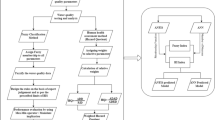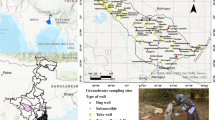Abstract
Diatoms are ideal indicators of certain physical-chemical parameters and in the relevant literature they are classified into one of the water quality classes (WQCs). Using information technologies methods, we can classify old and new diatoms directly from measured data. In this direction, a novel method for diatom classification is proposed in this paper. The classification models are induced by using modified bell fuzzy membership functions (MFs) in order to make more accurate models. An intensive comparison study of the fuzzy MFs distribution with the proposed method and the classical classification algorithms on the classification accuracy is studied. Based on this evaluation results, three models are presented and discussed. The experimental results have shown that the proposed algorithm remains interpretable, robust on data change and achieve highest classification accuracy. The obtain results from the classification models are verified with existing diatom ecological preference and for some diatoms new knowledge is added.
Access this chapter
Tax calculation will be finalised at checkout
Purchases are for personal use only
Preview
Unable to display preview. Download preview PDF.
Similar content being viewed by others
References
Krstič, S.: Description of sampling sites. FP6-project TRABOREMA: Deliverable 2.2 (2005)
Levkov, Z., Krstič, S., Metzeltin, D., Nakov, T.: Diatoms of Lakes Prespa and Ohrid (Macedonia). Iconographia Diatomologica 16, 603 (2006)
Kóczy, L.T., Vámos, T., Biró, G.: Fuzzy signatures. In: EUROFUSE-SIC, pp. 210–217 (1999)
Naumoski, A., Kocev, D., Atanasova, N., Mitreski, K., Krtić, S., Džeroski, S.: Predicting chemical parameters of water quality form diatoms abundance in Lake Prespa and its tributaries. In: 4th International ICSC Symposium on Information Technologies in Environmental Engineering - ITEE 2009, Thessaloniki, Greece, pp. 264–277. Springer, Heidelberg (2009)
Nikravesh, M.: Soft computing for perception-based decision processing and analysis: web-based BISC-DSS. Studies in Fuzziness and Soft Computing, vol. 164, pp. 93–188. Springer, Heidelberg (2005)
TRABOREMA Project WP3.: EC FP6-INCO project no. INCO-CT-2004-509177 (2005-2007)
Schweizer, B., Sklar, A.: Associative functions and abstract semigroups. Publ. Math. Debrecen 10, 69–81 (1963)
Olaru, C., Wehenkel, L.: A complete fuzzy decision tree technique. Fuzzy Sets and Systems 138, 221–254 (2003)
Yuan, Y., Shaw, M.J.: Induction of fuzzy decision trees. Fuzzy Sets and Systems 69(2), 125–139 (1995)
Quinlan, R.J.: Decision trees and decision making. IEEE Transactions on Systems, Man, and Cybernetics 20(2), 339–346 (1990)
Janikow, C.Z.: Fuzzy decision trees: issues and methods. IEEE Transactions on Systems, Man, and Cybernetics 28(1), 1–14 (1998)
Wang, L.X., Mendel, J.M.: Generating fuzzy rules by learning from examples. IEEE Transactions on Systems, Man, and Cybernetics 22(6), 1414–1427 (1992)
Wang, X., Chen, B., Olan, G., Ye, F.: On the optimization of fuzzy decision trees. Fuzzy Sets and Systems 112, 117–125 (2000)
Suárez, A., Lutsko, J.F.: Globally optimal fuzzy decision trees for classification and regression. IEEE Transactions on Pattern Analysis and Machine Intelligence 21(12), 1297–1311 (1999)
Kocev, D., Naumoski, A., Mitreski, K., Krstić, S., Džeroski, S.: Learning habitat models for the diatom community in Lake Prespa. Journal of Ecological Modelling 221(2), 330–337 (2009)
Krammer, K., Lange-Bertalot, H.: Die Ssswasserflora von Mitteleuropa 2: Bacillariophyceae. 1 Teil, p. 876. Gustav Fischer-Verlag, Stuttgart (1986)
Van Der Werff, A., Huls, H.: Diatomeanflora van Nederland. Abcoude - De Hoef (1957, 1974)
Stroemer, E.F., Smol, J.P.: The diatoms: Applications for the Environmental and Earth Sciences. Cambridge University Press, Cambridge (2004)
Van Dam, H., Martens, A., Sinkeldam, J.: A coded checklist and ecological indicator values of freshwater diatoms from the Netherlands. Netherlands Journal of Aquatic Ecology 28(1), 117–133 (1994)
Huang, Z.H., Gedeon, T.D., Nikravesh, M.: Pattern Trees Induction: A New Machine Learning Method. IEEE Transaction on Fuzzy Systems 16(3), 958–970 (2008)
Gold, C., Feurtet-Mazel, A., Coste, M., Boudou, A.: Field transfer of periphytic diatom communities to assess shortterm structural effects of metals (Cd Zn) in rivers. Water Research 36, 3654–3664 (2002)
Author information
Authors and Affiliations
Editor information
Editors and Affiliations
Rights and permissions
Copyright information
© 2011 Springer-Verlag Berlin Heidelberg
About this paper
Cite this paper
Naumoski, A., Mitreski, K. (2011). Diatom Classification with Novel Bell Based Classification Algorithm. In: Gusev, M., Mitrevski, P. (eds) ICT Innovations 2010. ICT Innovations 2010. Communications in Computer and Information Science, vol 83. Springer, Berlin, Heidelberg. https://doi.org/10.1007/978-3-642-19325-5_25
Download citation
DOI: https://doi.org/10.1007/978-3-642-19325-5_25
Publisher Name: Springer, Berlin, Heidelberg
Print ISBN: 978-3-642-19324-8
Online ISBN: 978-3-642-19325-5
eBook Packages: Computer ScienceComputer Science (R0)




